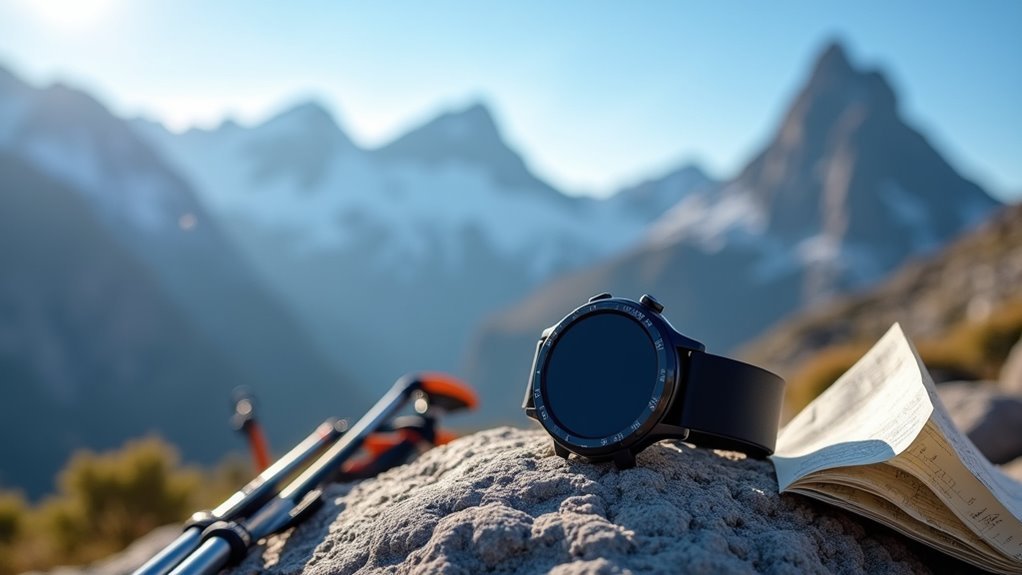You can prevent altitude sickness using your sport watch by monitoring SpO2 levels continuously during ascent, setting alerts for readings below 80% at elevations above 2,500 meters. Track your heart rate patterns to assess acclimatization—expect a 10-30% increase initially that should stabilize over days. Use elevation data to plan gradual ascents of only 500 meters daily above 2,500 meters, and analyze sleep metrics to gauge recovery quality. These advanced features provide early warning signs up to 10 days before symptoms appear, giving you thorough insights into your body’s high-altitude adaptation.
Monitor Your SpO2 Levels in Real-Time During Ascent

Modern sport watches equipped with pulse oximetry sensors give you a powerful advantage when climbing to high altitudes—they’ll track your blood oxygen saturation (SpO2) levels continuously as you ascend.
Devices like the COROS Vertix automatically prompt SpO2 checks when you reach 2500 meters, providing real-time readings that serve as early warning signs for declining oxygen levels.
Advanced watches like the COROS Vertix trigger automatic oxygen monitoring at 2500 meters, delivering instant feedback on your body’s altitude response.
You’ll receive contextual alerts if your heart rate spikes unusually compared to your fitness baseline, helping you detect potential altitude sickness before symptoms worsen.
The continuous feed stores SpO2, heart rate, and elevation data, creating valuable trend analysis. For the most accurate readings, ensure your watch remains tightly positioned against your wrist throughout your climb.
This immediate, visualized feedback empowers you to make informed decisions about your ascent rate and when adjustments might be necessary.
Set Up Smart Alerts for Altitude Sickness Risk Detection
While monitoring your SpO2 provides valuable data, configuring intelligent alerts transforms your sport watch into a proactive safety system that warns you before altitude sickness becomes dangerous.
Set specific thresholds like SpO2 below 80% or elevated resting heart rates to trigger immediate notifications. You’ll want to establish altitude-based alerts starting at 2,500 meters, where oxygen saturation typically begins dropping considerably.
Configure your watch to combine multiple metrics—SpO2, heart rate variability, and perfusion index—for more accurate risk detection.
Enable real-time monitoring that considers your individual baseline data, since acclimatization varies between people. Include lifestyle factors like sleep quality and activity intensity in your alert system. Advanced algorithms can track resting heart rate patterns and detect physiological stress up to 10 days before you feel symptoms.
This thorough approach guarantees you’ll receive timely warnings, allowing you to descend or rest before symptoms worsen.
Track Your Heart Rate Patterns for Acclimatization Assessment
Beyond setting up alerts, your sport watch’s heart rate monitoring capabilities offer in-depth insights into how well you’re adapting to high altitude conditions.
Expect your resting heart rate to increase 10-30% due to reduced oxygen availability. During initial days at altitude, you’ll notice elevated heart rate and decreased stroke volume as your body compensates for hypobaric hypoxia.
Monitor heart rate variability (HRV) to track your autonomic nervous system’s response. Lower HRV indicates increased sympathetic activity, while improving HRV suggests better acclimatization. Research shows that ultra-short HRV measurements can be just as effective as traditional longer recordings for monitoring your body’s response to altitude changes.
Track trends over several days rather than single measurements, as your cardiac output typically returns to baseline after initial elevation while heart rate remains high.
Combine heart rate data with oxygen saturation readings and symptom tracking for thorough acclimatization assessment and early altitude sickness detection.
Use Elevation Data to Plan Gradual Ascent Schedules
Your sport watch’s barometric altimeter becomes an essential planning tool when implementing the “climb high, sleep low” principle for safe altitude gain.
Program elevation thresholds at 2,500 meters to trigger acclimatization alerts, ensuring you don’t exceed 500 meters daily ascent above this critical point. Use real-time elevation tracking to monitor your progress and adjust schedules accordingly.
Smart altitude monitoring at 2,500 meters prevents dangerous ascent rates while maintaining safe acclimatization progress through real-time elevation data.
Set intermediate waypoints at moderate altitudes like 1,500-2,200 meters for staged acclimatization stops. Your watch’s data analysis features help identify patterns in your altitude tolerance, enabling customized ascent plans based on your physiological responses.
Avoid direct flights to high elevations by planning 2-3 day acclimatization periods below 2,500 meters. Configure alerts for daily elevation gains, and utilize GPS navigation to stay on planned routes while maintaining peak ascent rates. Remember that sleeping altitude is more critical than the maximum elevation you reach during daytime activities.
Analyze Sleep and Recovery Metrics at High Altitude

As you ascend to higher elevations, your sport watch’s sleep tracking capabilities become essential for monitoring how altitude affects your rest and recovery patterns.
You’ll likely experience reduced REM sleep, difficulty falling asleep, and frequent awakenings during your initial days at high altitude. About 50% of athletes face severe disordered breathing upon ascent.
Monitor your heart rate variability (HRV) through your device to track recovery quality. Your watch’s activity algorithms can detect sleep-wake cycles and immobility patterns, providing valuable insights into adaptation progress.
Expect significant sleep disturbances initially, but quality gradually improves over several days to weeks. After approximately 8 days at 2000 meters, your HRV balance should return to within 4% of sea level averages.
Use real-time biometric feedback to adjust training intensity and recognize when you’re not recovering properly, preventing overexertion and reducing injury risk during acclimatization.
Frequently Asked Questions
Which Sport Watch Brands Are Most Accurate for Altitude Sickness Prevention?
You’ll find Garmin and Polar offer the most accurate altimeter readings for preventing altitude sickness. Their GPS calibration and high-resolution barometric sensors provide precise elevation tracking that’s essential for monitoring dangerous altitude changes.
How Long Should I Wear My Sport Watch Before High-Altitude Travel?
You should wear your sport watch for at least one to two weeks before high-altitude travel. This establishes baseline health metrics like heart rate and oxygen levels, helping you monitor changes during acclimatization.
Can Sport Watches Replace Medical Advice for Severe Altitude Sickness Symptoms?
You can’t replace medical advice with sport watches for severe altitude sickness symptoms. While they’re helpful for monitoring, you’ll need proper medical evaluation and treatment when facing serious high-altitude health complications.
Do Sport Watches Work Properly in Extreme Cold at High Altitudes?
You’ll find that modern sport watches generally work well in extreme cold at high altitudes, but you should expect reduced battery life and potential accuracy issues with mechanical components in temperatures below -4°F.
What Backup Methods Exist if My Sport Watch Battery Dies During Ascent?
You can carry backup batteries, portable chargers, or secondary GPS devices. Use topographic maps with compasses for navigation. Monitor your body’s physical symptoms and maintain gradual ascent schedules for safety.
In Summary
You’ve got powerful tools right on your wrist to prevent altitude sickness. By monitoring your SpO2, setting smart alerts, tracking heart rate patterns, planning gradual ascents with elevation data, and analyzing sleep metrics, you’ll climb safer and smarter. Don’t ignore what your sport watch is telling you—it’s designed to keep you healthy at altitude. Use these features consistently, and you’ll greatly reduce your risk of altitude-related problems.





Leave a Reply